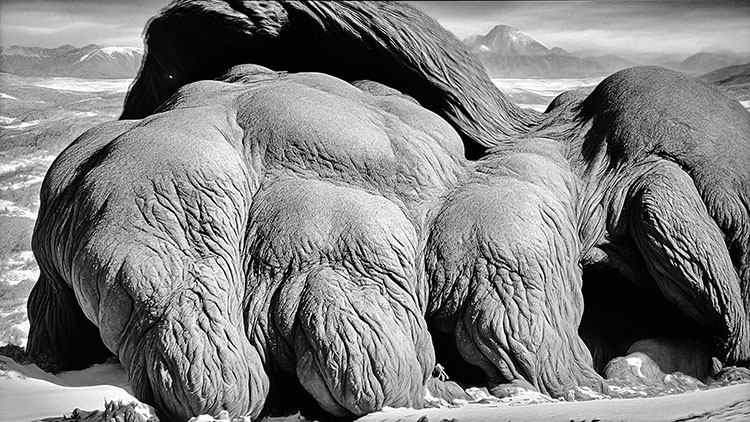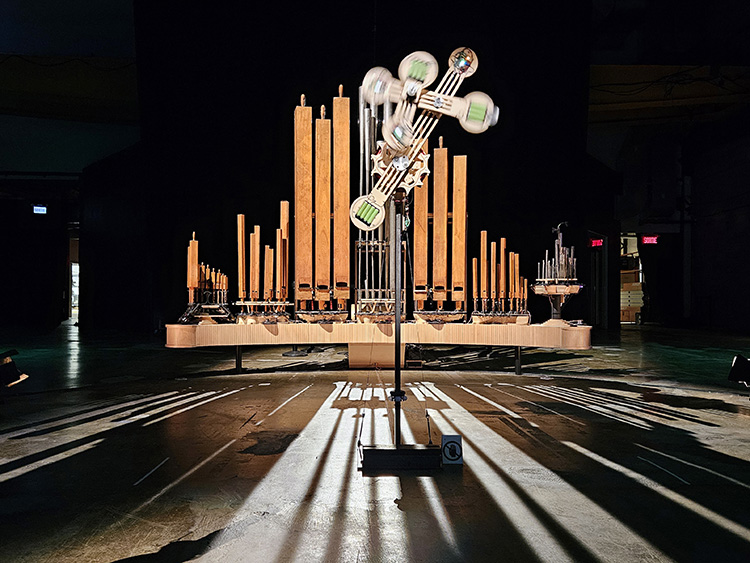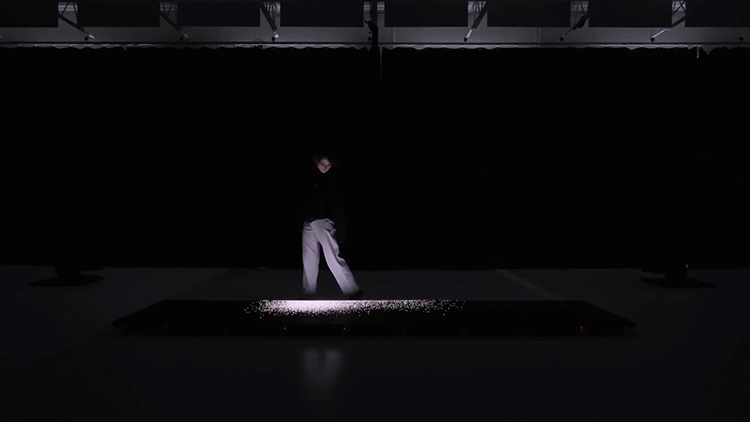7th Elektra Biennial
Montreal's seventh Elektra International Digital Art Biennial returns to Arsenal Contemporary Art, where curator Alain Thibault has brought together the creations of some thirty artists on the theme of Illusion.
To the sound of voice

David Rokeby, Voice Scroll, 2021-2024, en collaboration avec Awwal Malhi, Kathy Zhuang et Xavier Snelgrove.
If there's one interactive installation that got people talking, it was David Rokeby's Voice Scroll. It allows the public to vocally dictate situations that an artificial intelligence generates in real time from left to right. The panoramic image constantly unfolds according to the wishes expressed by those who take turns at the microphone. Although we are no strangers to this 'prompt' trend in art, we must admit that the extreme responsiveness of the artwork to the voice fascinates us, appearing to be so much closer to any desire than a keyboard would be.
Hybridization

Kurt D'Haeseleer, Animal Locomotion, 2023.
This seventh edition of Elektra is highly tinged with AI. More than ever, artists with a technological bent, like Kurt D'Haeseleer, are tempted to explore the possibilities opened up by generativity. In Animal Locomotion, he uses it to hybridize the human with the machine, having trained a model using sources that mix Edouard Muybridge with Boston Dynamics. The jerky animation with its outdated aesthetic evokes a temporality that also hybridises the past with the future.
Of the unknown

Sébastien Lacomblez et Emmanuel Pire, Les formes vides, 2024.
Nor has Sébastien Lacomblez resisted the siren calls of AI, collaborating with Emmanuel Pire to produce a strange creation entitled Les Formes Vides. The animation is captivating because of its transitions, as is often the case with generative sequences. In other words, when the algorithm invents alternative realities to move from what we know to what we still think we recognise. And it is in this interstice of the unknown that such proposals often seize us, taking us out of the ordinary world.
Laws of physics

Navid Navab, Organism & Excitable Chaos, 2024, en collaboration avec Garnet Willis.
The Elektra Biennial is a continuation of the festival of the same name, initially dedicated to the kind of performance art epitomised by the work of Navid Navab performing Organism at the fourteenth International Digital Art Market. His instrument is a pipe organ of the most analogue kind, but with a back end packed with electronics. And it is by combining it with the control of the triple pendulum of Excitable Chaos that the performance continues in the form of an autonomous installation. The music improvised according to the artist's pre-established rules is nothing other than the harmonious sounds of the laws of physics.
Interactive particles

Iregular, Nest, 2023.
Leaving the Arsenal behind, we head for the Mile End district, home to a host of art centres, artist-run spaces and other galleries, including Elektra, which presents the interactive audiovisual Nest by studio Iregular. Stretching across the floor, the LED screen is inhabited by a swarm of particles animated by behaviours evocative of a collective. The virtual swarm instantly begins to follow anyone informing themselves within the space of the work. The sound becomes more disquieting as the multitude is capable of splitting apart if anyone has the idea of disturbing the elastic relationship between the pixels and the irremediably tracked being. It's an installation that can be played with, encouraging the public to familiarise themselves with what could just as easily be seen as an instrument of body music.
At MAC de Montreal

Nelly-Eve Rajotte, Les arbres communiquent entre eux à 220 hertz, 2024.
No art lover would go to Montreal without visiting the Museum of Contemporary Art, which is currently undergoing renovations but is still operating outside its walls, albeit near rue Saint Catherine. Curator Marie-Eve Beaupré has assembled works by artists under the theme of "femmes volcans forêts torrents". These include works by Nelly-Eve Rajotte, who has scanned nature using Lidar. This technology, which is never truly neutral, is reminiscent of pointillism in painting. But what is most striking about the immersive work Les arbres communiquent entre eux (Trees communicate with one another) is the quality of its light. It's as if the artist has captured every photon of it. To the extent that the illumination of its undergrowth is on a par with the paintings of the Hudson River School.
At Phi Centre

Richard Mosse, Broken Spectre, 2022.
Lastly, at the a Phi Centre, there is a contemporary masterpiece presented by curator Myriam Achard. Richard Mosse's film installation Broken Spectre continues its world tour. His subject is deforestation in Amazonia, and he stretches out the representations within a panoramic image that he constantly recomposes over time on different screens. Fire has a predominant presence in the sequences, where shots are strung together from near to far, as if from black and white to colour. In this way, the artist attributes to the Anthropocene multiple forms that serve a single aesthetic, that of an experimental cinema at the crossroads of art and documentary, just as the Elektra Biennial is at the crossroads of art and digital.
Articles
- Paris Photo
- Art, technology and AI
- Immersive Art
- Chroniques Biennial
- 7th Elektra Biennial
- 60th Venice Biennial
- Endless Variations
- Multitude & Singularity
- Another perspective
- The Fusion of Possibilities
- Persistence & Exploration
- Image 3.0
- BioMedia
- 59th Venice Biennale
- Decision Making
- Intelligence in art
- Ars Electronica 2021
- Art & NFT
- Metamorphosis
- An atypical year
- Real Feelings
- Signal - Espace(s) Réciproque(s)
- On Combinations at Work
- Human Learning
- Attitudes and forms by women
- Ars Electronica 2019
- 58th Venice Biennale
- Art, Technology and Trends
- Art in Brussels
- Plurality Of Digital Practices
- The Chroniques Biennial
- Ars Electronica 2018
- Montreal BIAN 2018
- Art In The Age Of The Internet
- Art Brussels 2018
- At ZKM in Karlsruhe
- Lyon Biennale 2017
- Ars Electronica 2017
- Digital Media at Fresnoy
- Art Basel 2017
- 57th Venice Biennial
- Art Brussels 2017
- Ars Electronica, bits and atoms
- The BIAN Montreal: Automata
- Japan, art and innovation
- Electronic Superhighway
- Lyon Biennale 2015
- Ars Electronica 2015
- Art Basel 2015
- The WRO Biennale
- The 56th Venice Biennale
- TodaysArt, The Hague, 2014
- Ars Electronica 2014
- Basel - Digital in Art
- The BIAN Montreal: Physical/ity
- Berlin, festivals and galleries
- Unpainted Munich
- Lyon biennial and then
- Ars Electronica, Total Recall
- The 55th Venice Biennale
- The Elektra Festival of Montreal
- Digital practices of contemporary art
- Berlin, arts technologies and events
- Sound Art @ ZKM, MAC & 104
- Ars Electronica 2012
- Panorama, the fourteenth
- International Digital Arts Biennial
- ZKM, Transmediale, Ikeda and Bartholl
- The Gaîté Lyrique - a year already
- TodaysArt, Almost Cinema and STRP
- The Ars Electronica Festival in Linz
- 54th Venice Biennial
- Elektra, Montreal, 2011
- Pixelache, Helsinki, 2011
- Transmediale, Berlin, 2011
- The STRP festival of Eindhoven
- Ars Electronica repairs the world
- Festivals in the Île-de-France
- Trends in Art Today
- Emerging artistic practices
- The Angel of History
- The Lyon Biennial
- Ars Electronica, Human Nature
- The Venice Biennial
- Nemo & Co
- From Karlsruhe to Berlin
- Media Art in London
- Youniverse, the Seville Biennial
- Ars Electronica, a new cultural economy
- Social Networks and Sonic Practices
- Skin, Media and Interfaces
- Sparks, Pixels and Festivals
- Digital Art in Belgium
- Image Territories, The Fresnoy
- Ars Electronica, goodbye privacy
- Digital Art in Montreal
- C3, ZKM & V2
- Les arts médiatiques en Allemagne
- Grégory Chatonsky
- Le festival Arborescence 2006
- Sept ans d'Art Outsiders
- Le festival Ars Electronica 2006
- Le festival Sonar 2006
- La performance audiovisuelle
- Le festival Transmediale 2006
- Antoine Schmitt
- Eduardo Kac
- Captations et traitements temps réel
- Maurice Benayoun
- Japon, au pays des médias émergents
- Stéphane Maguet
- Les arts numériques à New York